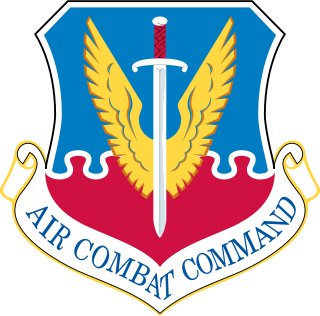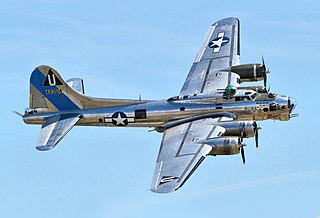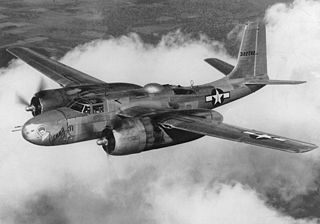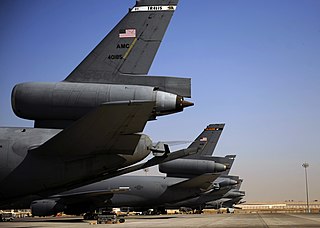This article needs additional citations for verification .(December 2012) (Learn how and when to remove this template message) |
| 22d Expeditionary Air Refueling Squadron | |
|---|---|
 376th Expeditionary Operations Group KC-135 at Manas [1] | |
| Active | 1939–1945; 1950–1962; 1963–1989; 1992–2002; 2003–present |
| Country | United States |
| Branch | United States Air Force |
| Role | Air Refueling |
| Garrison/HQ | Transit Center at Manas, Kyrgyz Republic |
| Nickname(s) | Mules |
| Engagements | South West Pacific Theater of World War II China Burma India Theater of World War II War in Afghanistan |
| Decorations | Distinguished Unit Citation Air Force Outstanding Unit Award |
| Insignia | |
| 22d Air Refueling Squadron emblem (Approved 15 November 1994) [2] |  |
| 22d Air Refueling Squadron emblem (Approved 13 December 1960) [3] |  |
| 22d Bombardment Squadron emblem (Approved 19 March 1945) [4] |  |
The 22d Expeditionary Air Refueling Squadron is a provisional United States Air Force unit, assigned to United States Air Forces Central. It is engaged in combat operations as part of the Global War on Terrorism in Afghanistan. Its current status and location are undetermined.

The United States Air Force (USAF) is the aerial and space warfare service branch of the United States Armed Forces. It is one of the five branches of the United States Armed Forces, and one of the seven American uniformed services. Initially formed as a part of the United States Army on 1 August 1907, the USAF was established as a separate branch of the U.S. Armed Forces on 18 September 1947 with the passing of the National Security Act of 1947. It is the youngest branch of the U.S. Armed Forces, and the fourth in order of precedence. The USAF is the largest and most technologically advanced air force in the world. The Air Force articulates its core missions as air and space superiority, global integrated intelligence, surveillance, and reconnaissance, rapid global mobility, global strike, and command and control.

The War in Afghanistan, code named Operation Enduring Freedom – Afghanistan (2001–14) and Operation Freedom's Sentinel (2015–present), followed the United States invasion of Afghanistan of 7 October 2001. The U.S. was initially supported by the United Kingdom, Canada, and Australia and later by a coalition of over 40 countries, including all NATO members. The war's public aims were to dismantle al-Qaeda and to deny it a safe base of operations in Afghanistan by removing the Taliban from power. The War in Afghanistan is the longest war in United States history.
Contents
- History
- World War II
- Strategic Air Command
- Mobility unit
- Lineage
- Assignments
- Stations
- Aircraft
- See also
- References
- Notes
- Bibliography
- External links
The squadron was previously designated as the 22d Air Refueling Squadron, and was an Air Mobility Command, Strategic Air Command, and Air Combat Command air refueling squadron, established in 1950.

Strategic Air Command (SAC) was both a United States Department of Defense (DoD) Specified Command and a United States Air Force (USAF) Major Command (MAJCOM), responsible for Cold War command and control of two of the three components of the U.S. military's strategic nuclear strike forces, the so-called "nuclear triad," with SAC having control of land-based strategic bomber aircraft and intercontinental ballistic missiles or ICBMs.

Air Combat Command (ACC) is one of ten Major Commands (MAJCOMs) in the United States Air Force, reporting to Headquarters, United States Air Force (HAF) at the Pentagon. It is the primary provider of air combat forces for the Air Force, and it is the direct successor to Tactical Air Command. Air Combat Command is headquartered at Langley Air Force Base, Joint Base Langley–Eustis, Virginia, United States.
During World War II, the 22d Bombardment Squadron was a heavy Boeing B-17 Flying Fortress and later, a medium B-25 Mitchell bomb squadron which fought in the Southwest Pacific and China-Burma-India theaters.

The Boeing B-17 Flying Fortress is a four-engined heavy bomber developed in the 1930s for the United States Army Air Corps (USAAC). Competing against Douglas and Martin for a contract to build 200 bombers, the Boeing entry outperformed both competitors and exceeded the air corps' performance specifications. Although Boeing lost the contract because the prototype crashed, the air corps ordered 13 more B-17s for further evaluation. From its introduction in 1938, the B-17 Flying Fortress evolved through numerous design advances, becoming the third-most produced bomber of all time, behind the four-engined B-24 and the multirole, twin-engined Ju 88.




























